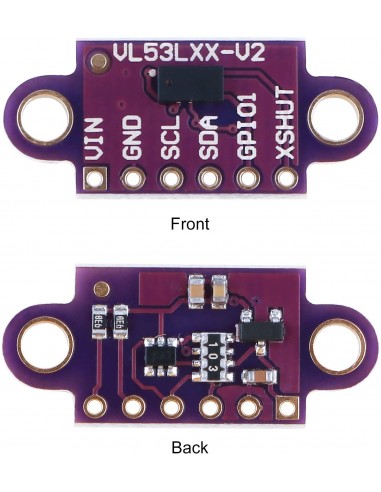



VL53L0X V2 laser ranging sensor
The ST Microelectronics VL53LxX is a flight time ranging from integrated system into a compact module. This forum is a support for the VL53L0X, we recommend that you carefully read the VL53L0X data sheet (pdf 1MB) before using this product.
The VL53L0 uses ST's FlightSense technology to accurately measure how long it takes to emit infrared laser light pulses to reach the nearest object and be returned to a detector, so it can be considered a system Lidar tiny and autonomous. This time-of-flight measurement (TOF) enables it to accurately determine the absolute distance of a target without greatly influencing the measurement of the reflectance of the object. The sensor can report distances of up to 2 m (6.6 ft.) With a resolution of 1 mm, but its range and accuracy (noise) are highly dependent on ambient conditions and target characteristics such as reflectance and size, Than the sensor configuration. (Sensor Accuracy is specified for range of ± 3% at best over at least 10% of optimum conditions.)
Measuring ranges are available through the I²C interface (TWI) of the probe, which is also used to configure the sensor parameters, and the sensor provides two additional pins: an input stop and an interrupt output .
The VL53L0X is a great IC, but its small LGA driverless case makes it difficult for the typical or amateur student to use. It also uses a recommended voltage of 2.8 V, which may complicate interlacing for 3.3V or 5V microcontrollers. Our derivation card addresses these issues, making it easier to start using the sensor, Keeping the size as small as possible.
PIN Description
The regulated DMV 2.8 V output. Nearly 150 mA is available at external power components. (If you want to bypass the internal controller, you can instead use this pin as a 2.8V input with VIN disconnected.)
VIN This is the main 2.6 V to 5.5 V power supply connection. The level controllers SCL and SDA pull the high I²C lines at this level.
GND the ground connection (0 V) for your power supply. Your source of control I²C must also share a common ground with this board.
SDA data line I²C shifted in the level: high is VIN, low 0 V
SCL line offset clock level I²C: high is VIN, low 0 V
XSHUT this pin is an active-low input stop; The board shoots up to the DMV to activate the default sensor. This spindle at the bottom steering wheel puts the sensor into standby hardware. This input is not shifted in the level.
You might also like